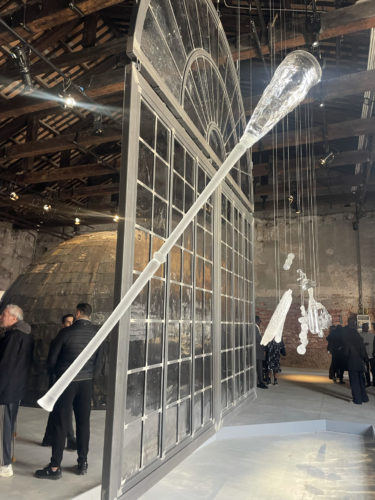Forgotten whispers, silenced cries,
Weaving unseen narratives,
Through pain and joy, their truths convene,
A kaleidoscope of humanity’s surge,
Minorities rise, in beauty crowned.
The return of artistic effervescence, a 2-year breath-hold navigating through cultural ambivalence. The 60th International Art Exhibition of La Biennale di Venezia titled “Stranieri Ovunque – Foreigners Everywhere” resuscitates, looking inwards into our cultural heritage, perhaps long gone, dusting out colonial tales and taboos we were told to leave unaddressed. Adriano Pedrosa, the director of MASP, the São Paulo Museum of Art, and the first commissioner of the Biennale from the southern hemisphere advocates for a politically and socially engaged direction for the 2024 edition. We’re here to tackle social norms.
So close but so far away – 0.9 miles from San Marco is, in reality, 3 islands away. The franchise Venice Water Buses or Vaporettos for the connoisseur are packed like peak time in the NYC subway. Our animal instincts are revived, fighting for life to ensure we get on board, jumping ropes, and pushing away elders for the sake of art. Every expedition to the Giardini feels like a Robison Crusoe sequence, a tale of survival, resilience, and the human spirit’s triumph over adversity.
A quest for art abundance, less is more, and vice versa. The press agency handed out a minimal book of 300 pages, disrupting my initial artistic curation. I only have 48 hours on the dash; therefore, let’s keep it real. It’s a tote bag parade, flexing proudly your latest acquisition from the Vogue Polska 9am-champagne-gathering. Melissa, 3 bags are more than enough, I know it’s the year sublimating minorities, but stay cool. As in Ikea, we are following an invisible line that could lead anywhere but most certainly to the next champagne opening.
Mad Crush
American Pavilion
“the space in which to place me” – Jeffrey Gibson
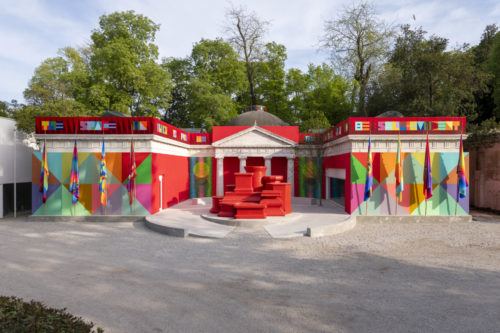
When the rain starts pouring, champagne glasses go missing – a dose of visual vibration can only patch the day up. Unapologetically kaleidoscopic – perhaps a wake-up call for a momentum of joy, the US Pavillion intercepts visitors trapped in a monotonous walk ritual. Re-enchanting our collective memory, two years ago, when Simone Leigh was already pimping the facade of the US National pavilion with a D’mba sculpture (a striking bust of a woman holding a sacred place within the spiritual practices of the Baga people of West Africa) rising 24 feet into the sky, thatch roofing, and wooden ornaments.
All eyes on Jeffrey Gibson doing it for the people – the first Indigenous artist (Choctaw and Cherokee descent) to represent the USA with a solo exhibition at the Biennale. Through ‘the space in which to place me’ Gibson reflected on a powerful narrative of inclusivity and identity – a visual metaphor for the complex layers of Indigenous histories. Vibrant tapestries adorned walls, and sculptures exuded a commanding presence, each telling a story of resilience and cultural pride. A mad crush for the video projection – your daily dose of psychedelics – performances enlightened by Indigenous dance and music, immersing viewers to experience the rhythmic pulse of tradition.
French Pavilion
“Attila cataract your source at feet of the green peaks will end up in the great sea blue Abby we drowned in the total tears of the moon” – Julien Creuzet
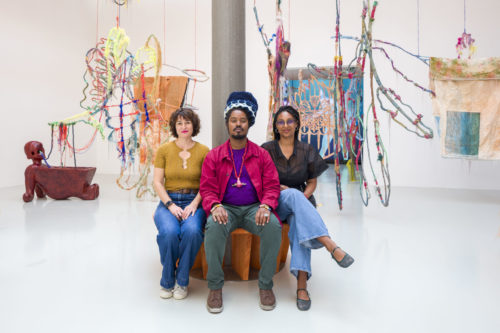
A few ancestral rituals and long-awaited collective manifestations brought to life the nomination of French–Caribbean artist Julien Creuzet. The motherland of Martinique is rising; in ex quo, my family’s WhatsApp group is on alert, naturally shifting into a kankan bureau (creole for neighborhood-PR-office in the Caribbean).
On a quest for identity, transcending a personal heritage crafted with pluralities and nomadic narratives, we are delving into l’outre-mer (ultramarin). I ditched my biennale partners, enchanted by the chant of a Creole mantra: “Attila cataract your source at the feet of the green peaks will end up in the great sea blue abyss we drowned in the tidal tears of the moon.” The visual poet revives the Caribbean myths – Attila claimed to draw his supernatural strength and health from the spring’s water that bears his name in Martinique. Ye Kri, ye kra, we shouted in unison.
A sensorial experience deeply rooted in bringing together collective experiences of displacement and migration, perhaps a prism for political tales. Emotional ambivalence, the installations evoke a sense of place and memory, weaving together fragments of history and contemporary life into cohesive and evocative narratives. Whispers of poetry as a common thread for arboreal sculptures, fluorescent marine life, and zombie figures sublimated with textures, luminosities, obscurities, and conceptual sonorities. Julien Creuzet crafted immersive environments that blur the boundaries between past and present, inviting viewers to contemplate the complexities of belonging and cultural hybridity.
Polish Pavilion
Repeat After Me II – Open Group

Artistic expression as a beacon of resilience, a means of navigating the tumultuous landscapes of war. The Ukrainian collective Open Group framed a thought-provoking exploration of collective memory and political symbolism rising up the power dynamics inherent in public spaces.
The audiovisual video installation “Repeat After Me II” captures the complexities of human experience, offering solace, resistance, and hope amidst the chaos. The juxtaposition of witnesses to the ongoing war in Ukraine explores the unconscious mechanism prevailing between art and war as a form of communication, documentation, protest, and healing.
A military karaoke of the future inviting viewers to “repeat after me” prompted the sounds of resistance sung by those who face this oppression. Open Group initiated a dialogue on how language, ideology, and propaganda shape our understanding of present circumstances, underscoring the importance of critical thinking and historical awareness.
Arsenal
Senegal Pavilion
“Bokk – Limites” – Alioune Diagne
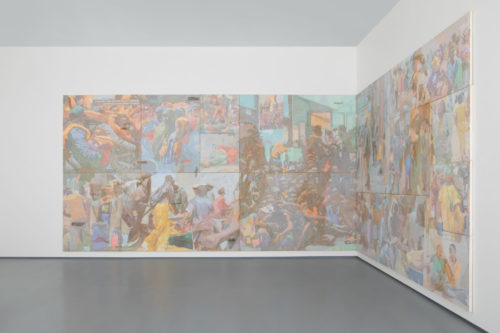
(extract from interview with artist)
BATE OU DEUGNE YOMBA NA JAMA (wolof proverb -The voice of truth is easily known).
A four-by-twelve-meter mosaic as a statement, we’re delving into Alioune Diagne’s commendited exploration for a portrayal of truth. Chromatic oscillations and symbolic fragments, the visual activist explores the complexities of contemporary Senegalese society and the universal themes that unite us all. A vivid reminder that closing your eyes isn’t going to change the reality.
“Figuro-abstro,” a term coined by Diagne himself, reflects his unique fusion of figurative and abstract elements, creating a visual language of figurative calligraphies. Not trying to be a snitch – some viewers were posted in front of the installation attempting to interpret the signaletic like the Da Vinci Code.
The “Bokk – Limites” functions as a platform for Diagne to interrogate the limits imposed by society, culture, and history, challenging viewers to confront the barriers that inhibit progress and inclusivity. Through a series of immersive paintings forming one fresco, he initiates a conversation on racial discrimination and environmental degradation, offering a nuanced perspective on present Senegal’s dilemmas – a dose of reality check.
From left to right, the narrative gradually arises, depicting the central role of women in maintaining social cohesion and perpetuating traditions, the emergence of the diaspora, and the cultural resonance – unfolding a glimmer of hope for the future.
Benin Pavilion
“Everything previous is fragile” – Chloé Quenum
(extract from interview with artist)
Shine bright – Benin, alongside Ethiopia and Tanzania, debuted a national pavilion for the first time at the Venice Biennale. A cultural momentum reflecting Benin’s dedication to preserving its cultural heritage and reclaiming its historical legacy catalyzed by the recent return of 26 royal treasures looted during the French colonial conquest of the Danxomè Kingdom.
Fragments of glass levitating across the Arsenal colonial portals hold the troops – I’m weak on the bling-bling side. Chloé Quenum revived Benin’s cultural aura through blown glass, sublimating the 26 instruments (flutes, bells, xylophones, and other objects) that were restored by the Quai Branly. A vivid recollection of glories collected throughout the ancient kingdom of Dahomey, an emphasis on the complexity of territories and temporality of objects. A time when Porcelain and glass were trading currencies, so spare me with your 5-dollar bill. Chloé Quenum navigates with profound sensitivity and depth within the complexities of history and belonging – a compelling exploration crystalizing our memory.
On Da Go
If time is not the limit, or perhaps you may be on a nomadic agenda as the pigeons of Plaza San Marco, I suggest showing some love to the following exhibitions.
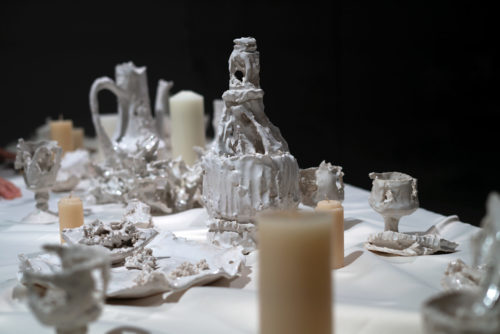
“Romantic Ireland” by Eimear Walshe – a multi-channel video installation reflecting on contestation and identity in Ireland. A romance guerilla with drama, melancholy, and satire – tales initiating conversations. Abraham Oghobase at the Nigerian National Pavilion invites viewers to confront the legacies of colonialism, to reexamine their relationship to the land, and to reimagine new modes of representation. Decades of mining ceased at the Jos Plateau in Nigeria, inspiring Oghobase to collect fragments of untold narratives. Erick Mayenberg‘s “As We Marched Away, we’re Always Coming Back” at the Mexican Pavilion explores interracial bonds, rituals, and immigration asylum with imported enriched ceramic sculptures rooted in his DNA. Mounira Al Solh‘s “A Dance with Her Myth” at the Lebanon Pavilion questions the very thin line between myth and reality – with an emphasis on the challenges currently facing women, using 41 visual means. A mad crush for Aleksandar Denic‘s “Exposition Coloniale” at the Serbian Pavilion, subtly addressing ongoing reverberations on what being a foreigner in your own country is like. A visual stimulation guarantee with the pimp Louis Vuitton / Versace wooden farm toilets. A must in times of struggle.
More information about the Art Biennale 2024
https://www.labiennale.org/
Merci to Luca di Parigi for the visual and culinary guidance


